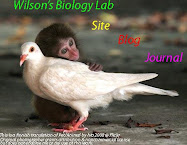A New Way to Create Stem Cells?
By Ben Irving, Georgina Johnson, Scott Kaufman
By Ben Irving, Georgina Johnson, Scott Kaufman
Stem cells are non-specialized cells that are both capable of renewing themselves and becoming specialized tissue and organ cells through cell division (cloning/asexually reproducing). In some organs or tissue, like bone marrow, stem cells regularly divide to repair and replace worn out or damaged tissues. In other organs, however, such as the pancreas and the heart, stem cells only divide under special conditions. Their ability to regenerate and repair tissues and organs makes them a fascinating area of exploration and hope for curing disease.
Until recently, two kinds of stem cells from animals and humans were used: embryonic stem cells and non-embryonic "somatic" or "adult" tissue stem cells. Embryonic stem cells are undifferentiated cells taken from embryos, whereas adult stem cells are undifferentiated cells found in some organs. The controversy over embryonic stem cells has raged on since their usefulness was discovered. Many believe that the gathering of embryonic stem cells kill innocent children, thus never giving them a chance to experience the world. Others believe that by doing this, they save an unwanted child, and help someone receive urgent medical care. Adult stem cells are rare to find and also have a limited capacity for reproducing and differentiating. So adult stem cells are not very useful.
In 2006, researchers developed a way to genetically "reprogram" some specialized adult cells to become stem cell-like. This new type of stem cell is called induced pluripotent stem cells (iPSCs). It is not known how iPSCs differ from embryonic stem cells. IPSCs have been created from mouse embryos as well as human embryos.
Now scientists at the University of Missouri have developed new a way of creating stem cells from regular cells taken from pig tissue, known as fibroblasts. These scientists have have been able to convert the fibroblasts to stem cells through inserting four specific genes into the fibroblast cells. Being able to use pigs is helpful because they are more similar to humans as opposed to mice. In addition, the pigs have a longer lifespan than mice, allowing the scientist to observe the long term effects. However, the scientists have not yet figured out how to program the stem cells to develop into one type of specialized cell rather than a mixture. They will need to learn how to achieve this before the new tissues can be transplanted back into the animal.
Despite all the progress made it could still take years before these stems cells can be put to the test. A major benefit of this research would be having tissue that could be transplanted back into the donor, so as to eliminate incompatibility between donor and receiver (rejection). The stem cells could also be used to create good cells to try out therapies, such as drug therapies, on tissues more similar to humans than mice tissues. They also provide a good testing opportunity to research how to reprogram the cells. However, other problems with stem cell research may not be solved with pig tissues, such as the problem of tumor growth. Finally, some may wonder if it is ethical or humane to sacrifice pigs for this research.
Here is the link to the article - http://www.sciencedaily.com/releases/2009/06/090625141508.htm
Acknowledgements:
http://www.animaldefense.com/A_images/pig.jpg
http://dawnofanewera.files.wordpress.com/2009/09/baby-pig.jpg
http://www.innocentenglish.com/wp/wp-content/uploads/2008/02/valentines-day-pig.jpg
http://9freepictures.com/d/file/animals-pictures/200908/baby-pig-68-2.jpg
http://www.hedweb.com/animimag/piglets.jpg
http://www.troedyrhiw.com/Kune%20Kune%20Pigs/kune%20kune%20piglets.jpg
http://blogs.guardian.co.uk/food/piglets440.jpg
http://oldstersview.files.wordpress.com/2007/11/four-piglets-front-view-jpg.jpg
https://www.shopelysiumartists.com/images/Piglets---w.jpg
http://www.vetscite.org/publish/articles/000075/Figure%2010.%20Piglets%20in%20nursery%20pen%20without%20sowverkl.jpg
http://www.animalpicturesarchive.com/animal/a1/White_Domestic_Piglets_J01.jpg
http://www.hedweb.com/animimag/piglet2.jpg
http://www.museums.norfolk.gov.uk/img/Piglets.jpg
http://www.hedweb.com/animimag/pig.jpg
http://www.uth.tmc.edu/schools/med/neurology/specialty-programs/ut-stroke/images/stem-cells.jpg
http://trickyrelativity.files.wordpress.com/2009/11/fetus.jpghttp://www.sciencedaily.com/releases/2009/06/090625141508.htm
http://stemcells.nih.gov
http://www.isscr.org/science/faq.htm#2
http://www.heritage.org/Research/Reports/2005/05/Federal-Stem-Cell-Research-What-Taxpayers-Should-Knowhttp://docs.google.com/present/edit?id=0AXCgd83IlAm3ZGducDQ2OTlfOTBkcjUyajNkcw&hl=en





No comments:
Post a Comment